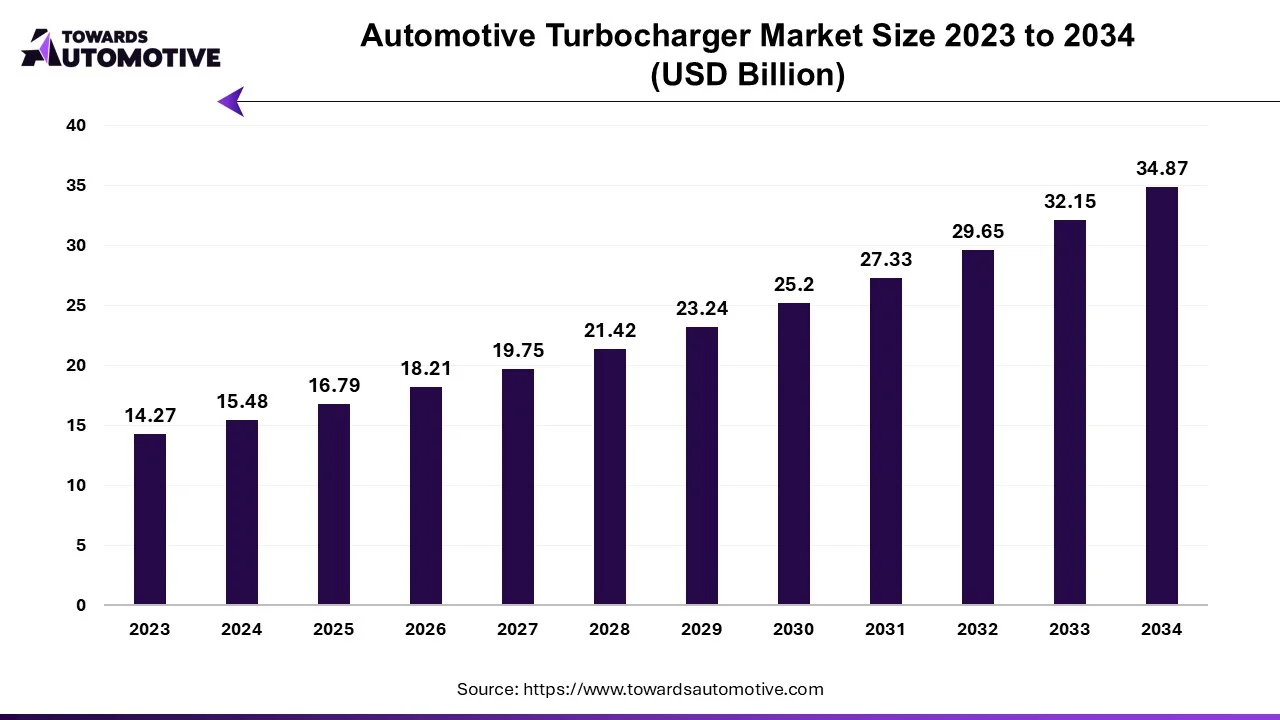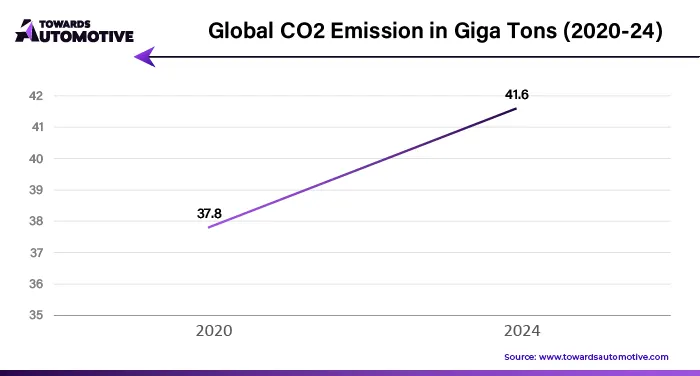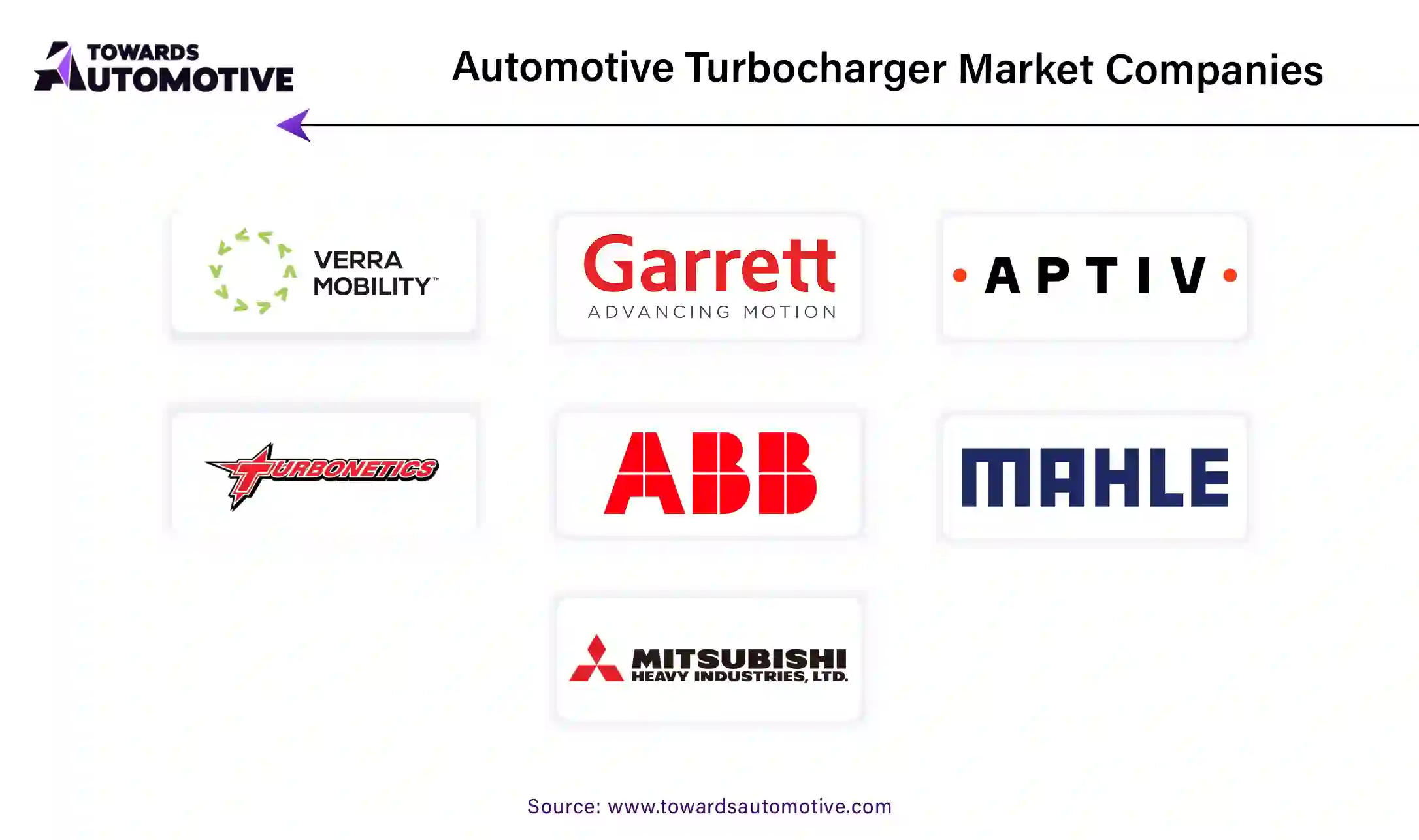April 2025
The global automotive turbocharger market is expected to grow from USD 16.79 billion in 2025 to USD 34.87 billion by 2034, with a CAGR of 8.46% throughout the forecast period from 2025 to 2034.
Unlock Infinite Advantages: Subscribe to Annual Membership
The automotive turbocharger market is experiencing steady growth driven by the increasing demand for enhanced engine performance, fuel efficiency, and stringent emission regulations. A turbocharger forces more air into the engine’s combustion chamber that enables smaller engines to produce more power while maintaining or improving fuel efficiency. As automakers strive to meet global environmental standards and consumer preferences for fuel-efficient vehicles, turbochargers are becoming an integral part of automotive design. These systems are particularly popular in internal combustion engines (ICE), where they help reduce emissions and improve fuel economy without compromising on power.
The market for automotive turbochargers is being further fueled by advancements in technology, such as variable geometry turbochargers (VGT) and twin-turbocharging systems, which offer improved performance and responsiveness. The shift towards smaller, more efficient engines in modern vehicles also drives the demand for turbocharging solutions. Additionally, the growing popularity of performance-oriented cars and the need to reduce the carbon footprint are significant factors influencing market growth. As consumers and manufacturers alike continue to prioritize sustainability and efficiency, the automotive turbocharger market is poised for continued expansion.
Emerging markets, especially in Asia-Pacific, are contributing to this growth, where rising disposable incomes and automotive production are creating new opportunities for turbocharger adoption. With the automotive industry’s ongoing focus on eco-friendly solutions, turbochargers are expected to play a crucial role in shaping the future of vehicle powertrains, contributing to the development of high-performance, fuel-efficient vehicles worldwide.
Artificial Intelligence (AI) is playing an increasingly important role in the automotive turbocharger market by enhancing turbocharger design, performance, and efficiency. AI technologies, such as machine learning and data analytics, are being utilized to optimize turbocharger operation and predict maintenance needs, contributing to improved overall vehicle performance and reduced downtime. For instance, AI algorithms can analyze real-time data from sensors within the turbocharger system to fine-tune its operation, ensuring optimal performance under varying driving conditions. This helps in improving fuel efficiency, reducing emissions, and enhancing engine output, all of which are critical for meeting stringent global emissions standards and consumer demands for better performance and sustainability.
AI is also being used in the design phase to enhance turbocharger efficiency. By using AI-driven simulations, manufacturers can test various designs and materials in virtual environments, significantly reducing development time and costs. These simulations can also predict potential failure points, leading to the production of more reliable and durable turbochargers.
Moreover, AI is enabling the integration of smart turbocharging systems, where sensors and control units work together to adapt turbocharger performance in real time based on driving behavior and environmental conditions. This adaptive approach allows for more efficient fuel consumption and emissions control, aligning with the automotive industry's shift towards eco-friendly, high-performance vehicles. As AI continues to evolve, its influence on the automotive turbocharger market will drive further innovation, improving vehicle efficiency, power, and overall driving experience.
Rising awareness for reducing emissions is a significant driver of growth in the automotive turbocharger market, as consumers, governments, and manufacturers increasingly focus on sustainability and environmental responsibility. Turbochargers play a pivotal role in meeting stricter global emissions regulations by improving engine efficiency and reducing fuel consumption. By forcing more air into the engine, turbochargers help ensure a more complete combustion process, which reduces the release of harmful pollutants like CO2, NOx, and particulate matter. This enhanced combustion efficiency allows manufacturers to comply with stringent emissions standards, such as Euro VI and Bharat Stage VI, without compromising engine performance.
As environmental concerns continue to grow and governments around the world implement tougher regulations to curb carbon emissions, the automotive industry is under pressure to adopt cleaner technologies. Turbochargers enable automakers to meet these standards while still offering powerful and efficient engines. For instance, turbocharging allows manufacturers to downsize engines, providing the same power output with reduced fuel consumption and lower emissions. This is particularly important in regions like Europe and North America, where emissions regulations are becoming more stringent.
Moreover, rising consumer awareness of environmental issues has increased demand for vehicles that offer both better fuel efficiency and lower emissions. As consumers seek greener options, automakers are increasingly turning to turbochargers to strike a balance between performance, fuel efficiency, and environmental responsibility. The growing push to reduce emissions is thus accelerating the adoption of turbochargers, driving market growth and helping the automotive industry transition toward more sustainable transportation solutions.

The automotive turbocharger market faces several restraints, including high production costs and the complexity of manufacturing advanced turbocharging technologies. Additionally, the increasing adoption of electric vehicles (EVs) presents a challenge, as turbochargers are primarily used in internal combustion engine (ICE) vehicles. Furthermore, the limited awareness of turbocharging benefits in some regions and concerns over the durability of turbocharged engines under extreme conditions may hinder market growth.
Twin-scroll turbochargers are creating significant opportunities in the automotive turbocharger market by offering enhanced performance, fuel efficiency, and reduced emissions compared to traditional single-scroll turbochargers. Twin-scroll technology utilizes two separate exhaust gas inlets, which divide the flow of exhaust gases into two distinct channels. This design improves the efficiency of the turbocharger by reducing turbo lag and enabling the engine to reach higher power outputs more quickly. The result is a more responsive engine that delivers better performance, particularly in smaller, downsized engines, which are increasingly used in passenger vehicles to meet fuel efficiency and emissions standards.
One of the key benefits of twin-scroll turbochargers is their ability to optimize fuel consumption and reduce engine stress by more efficiently harnessing exhaust gases. This technology allows automakers to produce smaller, more fuel-efficient engines without sacrificing performance, which aligns with the growing demand for environmentally friendly vehicles and compliance with stringent emissions regulations. As regulatory bodies worldwide, such as the European Union and the U.S. Environmental Protection Agency, impose stricter emissions standards, twin-scroll turbochargers help manufacturers meet these requirements without compromising engine power.
Moreover, the growing shift toward hybrid and electric powertrains in the automotive industry presents new opportunities for twin-scroll turbochargers. These turbochargers are increasingly integrated into hybrid powertrains to complement electric motors and optimize engine performance, further enhancing their value in the evolving automotive landscape. As automakers continue to prioritize fuel efficiency, performance, and emissions control, the adoption of twin-scroll turbochargers is expected to expand, driving growth in the automotive turbocharger market.
The diesel segment held the largest share of the market. The diesel segment plays a significant role in driving the growth of the automotive turbocharger market, primarily due to the growing demand for diesel-powered vehicles and the inherent benefits of turbocharging in diesel engines. Diesel engines are known for their superior fuel efficiency, torque, and performance, which make them particularly popular in commercial vehicles, heavy-duty trucks, and larger passenger vehicles. Turbochargers are essential in diesel engines as they enhance engine power and efficiency by forcing more air into the engine, allowing it to burn fuel more effectively. This results in improved fuel economy and reduced emissions, key factors in meeting stringent global environmental regulations, such as Euro VI and Bharat Stage VI standards.
In addition to improving fuel efficiency, turbocharging in diesel engines helps reduce the engine’s size and weight while maintaining performance, making it an attractive solution for both consumers and manufacturers. The growing demand for fuel-efficient, high-performance vehicles in regions with robust diesel vehicle markets, like Europe and parts of Asia-Pacific, is boosting the adoption of turbocharging technology in diesel engines.
Moreover, the shift toward diesel-powered commercial vehicles, which require engines with higher torque and reliability, further fuels the growth of the automotive turbocharger market. Turbochargers help optimize the performance of these heavy-duty vehicles, making them more efficient and environmentally compliant. As diesel engines continue to dominate the commercial vehicle sector and regulatory standards become stricter, the demand for turbochargers in the diesel segment will remain strong, driving market expansion.
The passenger cars segment led the industry. The passenger car segment plays a crucial role in driving the growth of the automotive turbocharger market, primarily due to the increasing consumer demand for high-performance, fuel-efficient vehicles. Turbocharging technology is increasingly integrated into passenger cars as automakers seek to enhance engine efficiency and reduce emissions while maintaining or improving power output.
As consumers become more environmentally conscious and fuel prices rise, there is a growing preference for vehicles that offer better fuel economy without sacrificing driving performance. Turbocharged engines provide the perfect solution by offering higher power output with improved fuel efficiency. Additionally, advancements in turbocharging technologies, such as variable geometry turbochargers (VGT) and twin-turbo systems, have made it possible for automakers to optimize fuel consumption and emissions, making turbocharged engines more attractive to environmentally aware consumers.
Furthermore, the shift toward electric and hybrid vehicles has contributed to the growing adoption of turbochargers in the passenger car segment. In hybrid powertrains, turbochargers complement electric motors to enhance performance and fuel economy. As demand for fuel-efficient, high-performance passenger vehicles continues to rise, turbochargers will remain a key technology in helping automakers meet these evolving consumer expectations and regulatory requirements.
Asia Pacific held the largest share of the market. Growing vehicle production and sales, rising environmental regulations, and the increasing adoption of hybrid vehicles are key drivers of the automotive turbocharger market in the Asia-Pacific (APAC) region. APAC is one of the largest and fastest-growing automotive markets globally, with countries like China, India, and Japan experiencing significant increases in vehicle production and sales. As automakers ramp up production to meet the growing demand for both passenger and commercial vehicles, turbochargers are increasingly used to enhance engine performance and fuel efficiency. Turbochargers enable manufacturers to offer smaller, more fuel-efficient engines without sacrificing power, which is crucial in meeting consumer expectations for both performance and sustainability.
Rising environmental regulations across APAC, particularly in China and India, are further propelling the adoption of turbochargers. Countries in the region are implementing stricter emissions standards, such as China VI and Bharat Stage VI (BS-VI), which require manufacturers to adopt technologies like turbocharging to reduce CO2 emissions and improve fuel efficiency. Turbochargers are essential in helping automakers meet these regulatory requirements by optimizing engine output while minimizing fuel consumption and emissions.
Additionally, the rising adoption of hybrid vehicles in APAC is driving market growth. Turbochargers play a key role in hybrid powertrains, where they complement electric motors to improve engine performance and fuel efficiency. As more consumers and manufacturers turn to hybrid vehicles for their environmental benefits, turbochargers are being integrated into these powertrains to optimize performance, making them an essential component in the region's evolving automotive landscape.
Europe is expected to grow at a notable rate in the automotive turbocharger market. The increasing demand for fuel-efficient vehicles, the automotive industry's shift toward downsized engines, and technological advancements in turbocharging are significant factors driving the growth of the automotive turbocharger market in Europe. As consumers become more environmentally conscious and fuel prices continue to rise, there is a growing preference for vehicles that offer better fuel economy without compromising on performance. Turbochargers play a crucial role in meeting this demand by enabling smaller, more fuel-efficient engines to deliver power equivalent to larger engines. This trend is particularly prominent in Europe, where stringent emissions regulations, such as the Euro 6 and Euro 7 standards, push automakers to adopt technologies that improve fuel efficiency while reducing CO2 emissions.
Furthermore, the automotive industry in Europe is increasingly shifting toward downsized engines to improve fuel efficiency and reduce environmental impact. Turbochargers are key components in these smaller engines, allowing them to provide the necessary performance without the fuel consumption of larger, traditional engines. This shift is evident in both passenger vehicles and commercial fleets, where turbocharging is used to maintain or enhance engine power while meeting stricter regulatory requirements.
Technological advancements in turbocharging, such as variable geometry turbochargers (VGT) and twin-turbo systems, are further propelling market growth by improving engine performance, efficiency, and responsiveness. These innovations allow turbochargers to adapt to different driving conditions, providing optimal fuel consumption and emissions control. As these trends continue to shape the European automotive market, turbochargers will remain a key technology in achieving a balance between performance, fuel efficiency, and environmental compliance.

By Fuel Type
By Technology Type
By Vehicle Type
By Region
April 2025
April 2025
April 2025
April 2025
Dr. Arjun Patel is a distinguished expert in the automotive industry, holding advanced degrees in Automotive Engineering and Mechanical Engineering. His expertise spans automotive market dynamics, technological advancements, and sustainable practices. Dr. Patel excels in conducting in depth research and analysis on market trends, consumer preferences, and the economic implications within the automotive sector. He is renowned for his insightful publications on topics such as electric vehicles, autonomous driving technologies, and the evolution of sustainable transportation solutions. Dr. Patels research contributions have significantly advanced understanding in the field, earning him recognition as a leading authority in automotive research and analysis.
We offer automotive expertise for market projections and customizable research, adaptable to diverse strategic approaches.
Contact Us